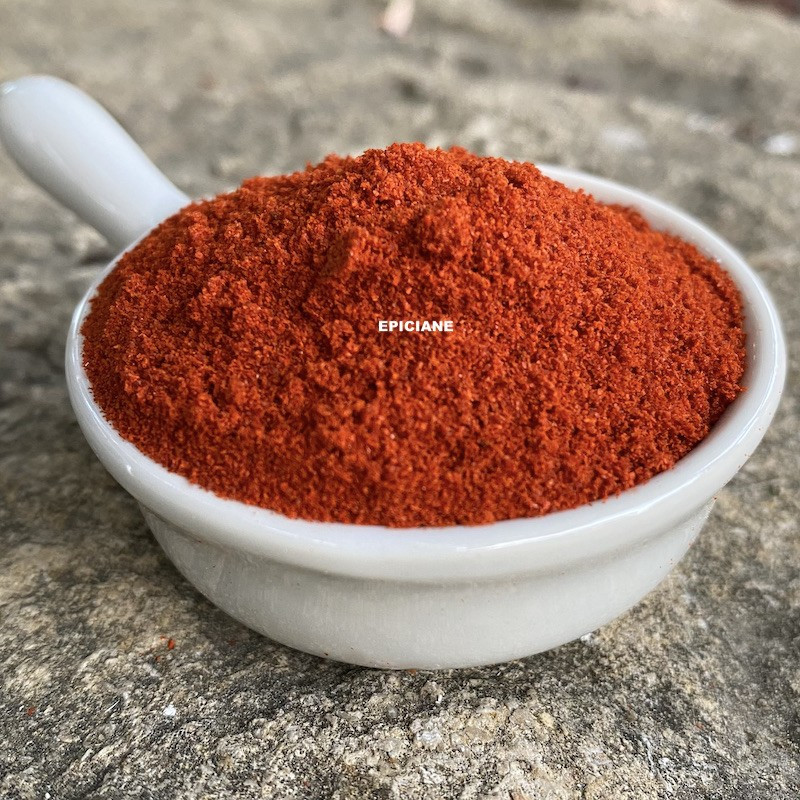
Reference: 20813701


Its taste is rich and very mild, almost sweet!
It adds flavor to goulashes and Central European cuisine, is part of the rouille that accompanies fish soup, and enhances eggs and dishes prepared "escabeche" style.
 Delivery
Delivery
Mondial Relay
 Returns
Returns
See conditions
 Payments
Payments
100% secure
Livré en sachet refermable
Uses in Cooking:
Paprika has a very mild, almost sweet, creamy flavor. Its vibrant red color adds visual appeal to dishes, bringing a beautiful warm hue to food.
It is used in Spanish escabeche preparations for mussels and fish, in potatoes, in certain cured meats like sobrasada and chorizo, and in Provence, it flavors rouilles that accompany fish soups. It is also delicious in a simple mayonnaise.
In Hungary, it is the main ingredient in goulash, and in Russia, it flavors borscht.
Paprika is excellent simply sprinkled over fried eggs, adding a lively touch to plates when dusted around the edges.
It is also widely present in Asian, North African, and Spanish cuisines.
Like all "peppers" (as they are from the same family!), paprika has antiseptic properties, making it valued in preserves for its color and flavor. It is also noteworthy for its iron content.
Who am I?
Origin: Spain
Scientific name: Capsicum annuum
Paprika is a variety of pepper from the Solanaceae family, like all peppers, whether sweet or hot.
The spice is made from the ripe fruit of the plant, with the inner seeds removed to further soften the flavor since capsaicin, the spicy (or burning) component in chilis, is concentrated in the seeds. The flesh is then dried and ground into powder. The color of paprika varies depending on the climatic conditions the plant experienced, but the dominant color remains red.
A Bit of History:
The name "paprika" is borrowed from Hungarian.
Originally, all peppers and chilis come from South America. Europeans discovered them during their explorations of these regions. Botanists gave the generic name "Capsicum" to the many and varied chili varieties as they were discovered. Some were used as vegetables (these are what we now call "bell peppers") or as spices, such as hot or sweet peppers and, of course, paprika.
As Europeans settled in America, they encountered an incredible diversity in shape, size, color, and flavor of these fruits. They can be round, long, tiny, or large, with colors ranging from almost white yellow to nearly black red, passing through every green hue. Generally, the smaller they are, the hotter they taste!
In discovering these plants, Europeans also found how easily they could crossbreed, creating infinite shapes and flavors. The seeds, easy to transport, were first acclimated and spread in Asia and Africa, leading many to believe they originated there. Later, the milder varieties arrived in Spain around the 17th century and eventually spread to Hungary, where paprika was even used as a substitute for pepper during times of scarcity or financial hardship.
Data sheet
 Jean-Pierre D.
Jean-Pierre D.
Pas encire utilisé !
 Anne Marie P.
Anne Marie P.
Bien

 Jean-Pierre D.
Jean-Pierre D.
Pas encire utilisé !
 Anne Marie P.
Anne Marie P.
Bien

Reference: 20813701
Reference: EPI2301003
Reference: 508212501
Reference: 20825701
Reference: 10203601
Reference: pimentjamaiqueE
Reference: 30803202
Reference: EPI230115
Reference: 20813802
Reference: 508212501
Reference: 00033663-0001
Reference: 124510
Reference: 408164502
Reference: EPI2301004
Reference: 021122
Reference: 108017302
Reference: 00022475-0001

Its taste is rich and very mild, almost sweet!
It adds flavor to goulashes and Central European cuisine, is part of the rouille that accompanies fish soup, and enhances eggs and dishes prepared "escabeche" style.